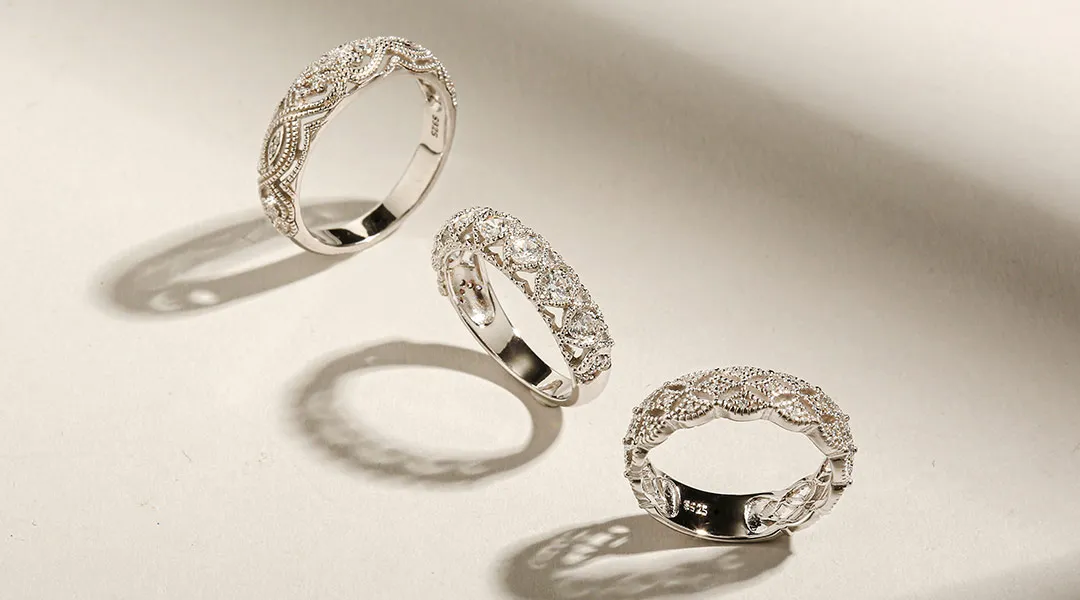Wedding bands are more than just symbols of love and commitment; they are steeped in tradition and history. Over the centuries, wedding bands have evolved, adapting to cultural shifts, new fashion trends, and advancements in jewelry craftsmanship. This article will explore the rich history of wedding bands and how modern trends are redefining this age-old symbol of union.
A Brief History of Wedding Bands
The tradition of wedding bands dates back thousands of years. It is believed that ancient Egyptians were among the first to exchange rings as a symbol of eternal love. They viewed the circular shape as a symbol of eternity, with no beginning and no end. These early rings were often made from reeds or plants, but as metallurgy advanced, materials like gold and silver became the standard.
The tradition spread to the Romans, who were the first to engrave their rings with personal messages or symbols, making the wedding band more personal and meaningful. In the Middle Ages, the practice of using precious metals such as gold became more common, and ornate designs featuring gemstones were introduced.
Wedding Bands Through the Ages
Victorian and Edwardian Eras
During the Victorian era (1837-1901), wedding bands took on a more romantic and elaborate style. Rings were often adorned with hearts, flowers, and even small locks and keys, symbolizing eternal love. This era also saw the introduction of diamonds and other precious stones in wedding bands.
In the Edwardian era (1901-1910), platinum became the preferred material for wedding bands due to its strength and ability to hold intricate details. Rings from this period often featured lace-like filigree work, a hallmark of the time’s craftsmanship.
The Modern Wedding Band: 20th Century and Beyond
In the 20th century, wedding bands became simpler, with plain gold bands gaining popularity due to their timeless elegance. The introduction of white gold in the 1920s offered couples an affordable alternative to platinum, and by the mid-20th century, matching wedding band sets for brides and grooms became a popular trend.
In the 1970s and 1980s, engraved messages inside wedding bands grew in popularity, allowing couples to add a personal touch to their rings. The idea of custom wedding bands began to take off as well, with couples seeking rings that reflected their unique personalities and stories.
Wedding Band Trends in the 21st Century
In recent years, wedding bands have continued to evolve, with new trends emerging that reflect contemporary tastes and values. Here are some of the most popular trends in wedding bands today:
1. Stacked Rings
One of the most popular trends is the use of stacked rings. Many brides now choose to wear multiple rings alongside their wedding band, including their engagement ring and eternity bands. These stacks allow for more personalization, as brides can mix different metals, styles, and gemstones to create a unique set.
2. Mixed Metals
Traditionally, wedding bands were made from a single metal, often yellow gold. However, modern couples are increasingly opting for mixed-metal designs. Combining metals like white gold, rose gold, and platinum offers a contemporary look that can be both elegant and unique.
3. Minimalist Designs
While elaborate and ornate rings are still in demand, there has been a growing trend towards minimalist wedding bands. Simple, sleek designs with clean lines are favored by couples looking for a more understated and timeless look.
4. Vintage and Heirloom Rings
Nostalgia plays a significant role in wedding band trends today. Many couples are choosing vintage-inspired designs or even repurposing family heirloom rings. This not only adds sentimental value but also reflects a growing trend toward sustainability in the jewelry industry.
5. Ethically Sourced and Eco-Friendly Materials
Sustainability has become a key concern for many couples. Wedding bands made from ethically sourced materials, including conflict-free diamonds and recycled metals, are becoming increasingly popular. Eco-friendly wedding bands reflect a commitment to responsible consumerism while maintaining elegance and style.
6. Personalized Wedding Bands
Customization has become a significant trend in wedding bands. Couples now have more options than ever to create a ring that is uniquely theirs. This can include engraving meaningful dates, names, or messages inside the band, incorporating birthstones or favorite gems, or even designing an entirely custom ring from scratch.
Cultural and Religious Wedding Band Traditions
Throughout history, various cultures have had unique wedding band traditions. For example, in Jewish tradition, the wedding band is a plain, unadorned ring, symbolizing the purity of the marriage. In Irish culture, the Claddagh ring, which features two hands holding a crowned heart, is a symbol of love, loyalty, and friendship and is often used as a wedding band.
In modern times, these cultural traditions continue to influence wedding band designs, with many couples choosing to incorporate symbols or elements from their heritage into their rings.
The Future of Wedding Bands: What’s Next?
As we look to the future, it’s clear that wedding bands will continue to evolve, with trends shaped by cultural shifts, technological advancements, and personal preferences. One area where we are likely to see more innovation is in the use of technology, such as 3D-printed rings or rings that incorporate smart technology to track heartbeats or other health metrics.
Additionally, the move towards sustainability is likely to continue influencing wedding band designs. As more couples seek out eco-friendly options, we may see a rise in alternative materials, such as lab-grown diamonds and recycled metals.
The evolution of wedding bands reflects both enduring traditions and changing trends. From ancient Egypt to the modern era, these symbols of love and commitment have adapted to reflect the values and tastes of the time. Today’s couples have more options than ever before, whether they choose a classic gold band, a custom-designed ring, or an eco-friendly alternative. Whatever the choice, wedding bands remain a timeless symbol of love that will continue to evolve for generations to come.
